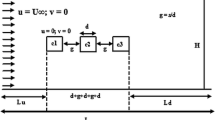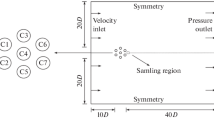Abstract—
A high-order discontinuous Galerkin method is employed to study the evolution of the flow structure in the gap and near wake of two tandem cylinders in the alternating in the gap (AG) regime. The transient characteristics of the flow, vorticity, and pressure fields, the transient circumferential pressure distribution, and the streamwise velocity along the centerline of the wake are studied under a Reynolds number of 200 and a pitch ratio of 2.3. The results show that the gap-flow occurs between the two tandem cylinders in the AG regime, and the gap-flow interacts with quasistatic vortices in the gap to cause unilateral or bilateral reattachment of the separated shear layer. In addition, under the influence of the gap-flow, a near-wake vortex is generated behind the downstream cylinder, which significantly affects the length of the recirculation bubble. Finally, the physical mechanism of reattachment of the shear layer and the generation of gap-flow in the AG regime are discussed.








Similar content being viewed by others
REFERENCES
M. Zdravkovich, “REVIEW—Review of Flow Interference Between Two Circular Cylinders in Various Arrangements,” ASME Transactions Journal of Fluids Engineering 99, 618–633 (1977).
D. Sumner, “Two circular cylinders in cross-flow: A review,” J. Fluids Structures 26(6), 849–899 (2010).
Y. Zhou and M. M. Alam, “Wake of two interacting circular cylinders: A review,” Int. J. Heat Fluid Flow 62, 510–537 (2016).
M. M. Zdravkovich, “The effects of interference between circular cylinders in cross flow,” J. Fluids Structures 1(2), 239–261 (1987).
B. S. Carmo, J. R. Meneghini, and S. J. Sherwin, “Secondary instabilities in the flow around two circular cylinders in tandem,” J. Fluid. Mech. 644, 395–431 (2010).
G. Xu and Y. Zhou, “Strouhal numbers in the wake of two inline cylinders,” Exp. Fluids. 37(2), 248–256 (2004).
T. Igarashi, “Characteristics of the flow around two circular cylinders arranged in tandem (1st report),” Bull. Japan. Soc. Mech. Eng. 24(188), 323–331 (1981).
R. Wang, H. B. Zhu, Y. Bao, D. Zhou, H. Ping, Z. L. Han, and H. Xu, “Modification of three-dimensional instability in the planar shear flow around two circular cylinders in tandem,” Phys. Fluids 31(10), 15 (2019).
L. J. Wang, M. M. Alam, and Y. Zhou, “Two tandem cylinders of different diameters in cross-flow: effect of an upstream cylinder on wake dynamics,” J. Fluid. Mech. 836, 5–42 (2018).
W. C. Yang and M. A. Stremler, “Critical spacing of stationary tandem circular cylinders at Re approximate to 100,” J. Fluids Structures 89, 49–60 (2019).
S. Mittal, V. Kumar, and A. Raghuvanshi, “Unsteady incompressible flows past two cylinders in tandem and staggered arrangements,” Int. J. Numer. Meth. Fluids 25, 1315–1344 (1997).
J. R. Meneghini, F. Saltara, C. L. R. Siqueira, and J. A. Ferrari, “Numerical simulation of flow interference between two circular cylinders in tandem and side-by-side arrangements,” J. Fluids Structures 15(2), 327–350 (2001).
W. Zhang, H. S. Dou, Z. C. Zhu, and Y. Li, “Unsteady characteristics of low-Re flow past two tandem cylinders,” Theor. Comput. Fluid Dyn. 32(4), 475–493 (2018).
A. R. Dwivedi and A. K. Dhiman, “Flow and heat transfer analysis around tandem cylinders: critical gap ratio and thermal cross-buoyancy,” J. Braz. Soc. Mech. Sci. Eng. 41(11), 25 (2019).
G. Schewe and M. Jacobs, “Experiments on the Flow around two tandem circular cylinders from sub- up to transcritical Reynolds numbers,” J. Fluids Structures 88, 148–166 (2019).
T. Kitagawa and H. Ohta, “Numerical investigation on flow around circular cylinders in tandem arrangement at a subcritical Reynolds number,” J. Fluids Structures 24(5), 680–699 (2008).
L. Ljungkrona and B. Sunden, “Flow visualization and surface pressure measurement on two tubes in an inline arrangement,” Exp. Therm. Fluid. Sci. 6(1), 15–27 (1993).
F. Zafar and M. M. Alam, “A low Reynolds number flow and heat transfer topology of a cylinder in a wake,” Phys. Fluids 30(8), 18 (2018).
J. S. Hesthaven, Nodal Discontinuous Galerkin Methods (Springer, New York, 2008).
F. C. Massa, G. Noventa, M. Lorini, F. Bassi, and A. Ghidoni, “High-order linearly implicit two-step peer schemes for the discontinuous Galerkin solution of the incompressible Navier–Stokes equations,” Computers Fluids 162, 55–71 (2018).
M. Paipuri, S. Fernández-Méndez, and C. Tiago, “Comparison of high-order continuous and hybridizable discontinuous Galerkin methods for incompressible fluid flow problems,” Mathematics and Computers in Simulation 153, 35–58 (2018).
H. Ding, C. Shu, K. S. Yeo, and D. Xu, “Numerical simulation of flows around two circular cylinders by mesh-free least square-based finite difference methods,” Int. J. Numer. Meth. Fl. 53(2), 305–332 (2007).
B. G. Dehkordi, H. S. Moghaddam, and H.H. Jafari, “Numerical simulation of flow over two circular cylinders in tandem arrangement,” J. Hydrodyn. 23(1), 114–126 (2011).
M. M. Alam, “Lift forces induced by phase lag between the vortex sheddings from two tandem bluff bodies,” J. Fluids Structures 65, 217–237 (2016).
A. Slaouti and P. K. Stansby, “Flow around two circular cylinders by the random-vortex method,” J. Fluids Structures 6(6), 641–670 (1992).
B. S. Carmo and J. R. Meneghini, “Numerical investigation of the flow around two circular cylinders in tandem,” J. Fluids Structures 22(6–7), 979–988 (2006).
G. E. Karniadakis, M. Israeli, and S. A. Orszag, “High-order splitting methods for the incompressible Navier–Stokes equations,” J. Comput. Phys. 97(2), 414–443 (1991).
H. Y. Jiang, L. Cheng, S. Draper, H. W. An, and F. F. Tong, “Three-dimensional direct numerical simulation of wake transitions of a circular cylinder,” J. Fluid. Mech. 801, 353–391 (2016).
T. Toulorge and W. Desmet, “Optimal Runge–Kutta schemes for discontinuous Galerkin space discretizations applied to wave propagation problems,” J. Comput. Phys. 231, 2067–2091 (2012).
N. Kroll, C. Hirsch, F. Bassi, C. Johnston, and K. Hillewaert, IDIHOM: Industrialization of High-Order Methods-A Top-Down Approach (Springer, New York, 2015).
W. J. Gordon and C. A. Hall, “Transfinite element methods: Blending-function interpolation over arbitrary curved element domains,” Numer. Math. 21(2), 109–129 (1973).
M. Darvishyadegari and R. Hassanzadeh, “Heat and fluid flow around two co-rotating cylinders in tandem arrangement,” Int. J. Therm. Sci. 135, 206–220 (2019).
N. Mahir and Z. Altac, “Numerical investigation of convective heat transfer in unsteady flow past two cylinders in tandem arrangements,” Int. J. Heat Fluid Flow 29(5), 1309–1318 (2008).
Y. Koda and F.S. Lien, “Aerodynamic effects of the early three-dimensional instabilities in the flow over one and two circular cylinders in tandem predicted by the lattice Boltzmann method,” Computers Fluids 74, 32–43 (2013).
G. V. Papaioannou, D. K. P. Yue, M. S. Triantafyllou, and G. E. Karniadakis, “Three-dimensionality effects in flow around two tandem cylinders,” J. Fluid. Mech. 558, 387–413 (2006).
M. M. Liu, “The predominant frequency for viscous flow past two tandem circular cylinders of different diameters at low Reynolds number,” Proc. Inst. Mech. Eng. Part M- J. Eng. Marit. Environ. 1–13 (2019).
M. Shaaban and A. Mohany, “Flow-induced vibration of three unevenly spaced in-line cylinders in cross-flow,” J. Fluids Structures 76, 367–383 (2018).
H. C. Vu, J. Ahn, and J. H. Hwang, “Numerical simulation of flow past two circular cylinders in tandem and side-by-side arrangement at low Reynolds numbers,” KSCE J. Civ. Eng. 20(4), 1594–1604 (2016).
S. Singha and K. P. Sinhamahapatra, “High-resolution numerical simulation of low Reynolds number incompressible flow about two cylinders in tandem,” J. Fluids Eng.-Trans. ASME 132(1), 10 (2010).
C. Norberg, “Fluctuating lift on a circular cylinder: review and new measurements,” J. Fluids Structures 17(1), 57–96 (2003).
C. H. K. Williamson, “2-D and 3-D aspects of the wake of a cylinder and their relation to wake computations,” Vortex Dynamics and Vortex Methods. 28, 719–751 (1991).
A. Roshko,"On the drag and shedding frequency of two-dimensional bluff bodies," Ed. by National Advisory Committee for Aeronautics (NACA) Washington: United States, 1954.
J. C. Lin, Y. Yang, and D. Rockwell, “Flow past two cylinders in tandem: instantaneous and averaged flow structure,” J. Fluids Structures 16(8), 1059–1071 (2002).
T. Igarashi and K. Suzuki, “Characteristics of the flow around three circular zylinders,” JSME International Journal 24(233), 2397–2404 (1984).
M. M. Alam, M. Moriya, K. Takai, and H. Sakamoto, “Fluctuating fluid forces acting on two circular cylinders in a tandem arrangement at a subcritical Reynolds number,” J. Wind. Eng. Ind. Aerodyn. 91(1), 139–154 (2003).
X. F. Hu, X. S. Zhang, and Y.X. You, “On the flow around two circular cylinders in tandem arrangement at high Reynolds numbers,” Ocean. Eng. 189, 20 (2019).
M. A. Prsic, M. C. Ong, B. Pettersen, and D. Myrhaug, “Large eddy simulations of flow around tandem circular cylinders in the vicinity of a plane wall,” J. Mar. Sci. Technol. 24(2), 338–358 (2019).
Funding
This work was supported by the National Natural Science Foundation of China (grant number 51108345), the State Key Laboratory for Civil Engineering and Disaster Prevention of China (grant number SLDRCE-MB-04), the Guangxi Key Laboratory of New Energy and Building Energy Saving (grant number 19-J-21-14), the Joint Cultivation Program of National Natural Science Foundations of Guangxi (grant number 2019JJA160127), the Guangxi Youth Innovative Talents Research Project (grant number 2019AC20022), the Special Talent Foundations of Guilin University of Technology (grant numbers RD19100163 and RD19100166), and the Liaoning Provincial Department of Education (grant number LJYL030).
Author information
Authors and Affiliations
Corresponding authors
Ethics declarations
The Authors declare no potential conflicts of interest with respect to the research, authorship, and/or publication of this article.
Rights and permissions
About this article
Cite this article
Shan, X., Sun, F. Evolution of the Flow Structure in the Gap and Near Wake of Two Tandem Cylinders in the AG Regime. Fluid Dyn 56, 309–320 (2021). https://doi.org/10.1134/S0015462821030095
Received:
Revised:
Accepted:
Published:
Issue Date:
DOI: https://doi.org/10.1134/S0015462821030095




